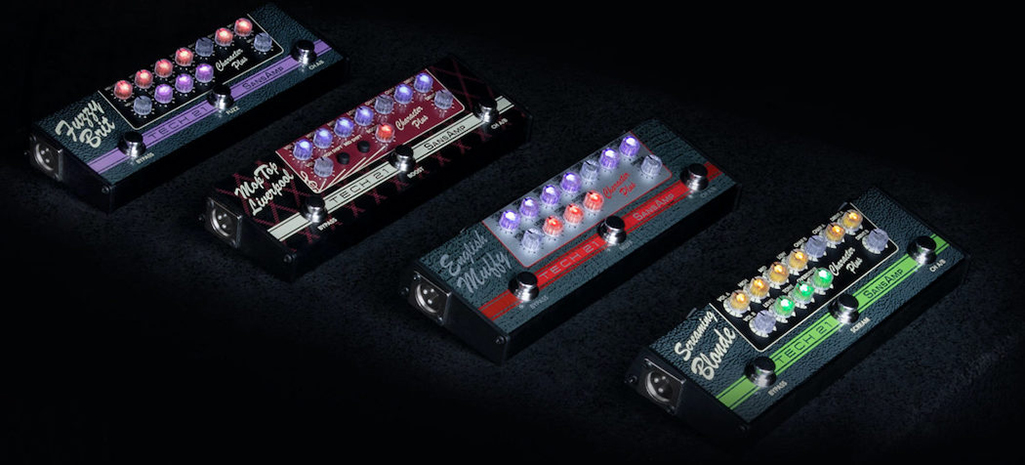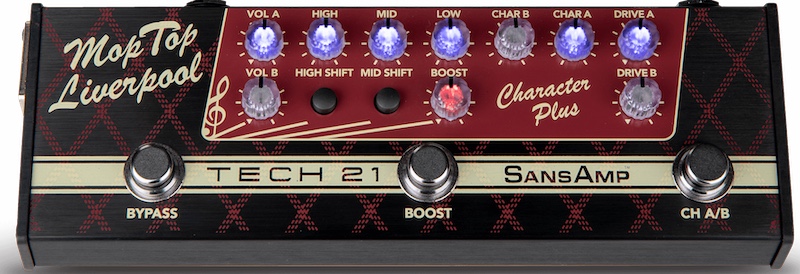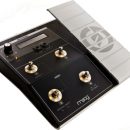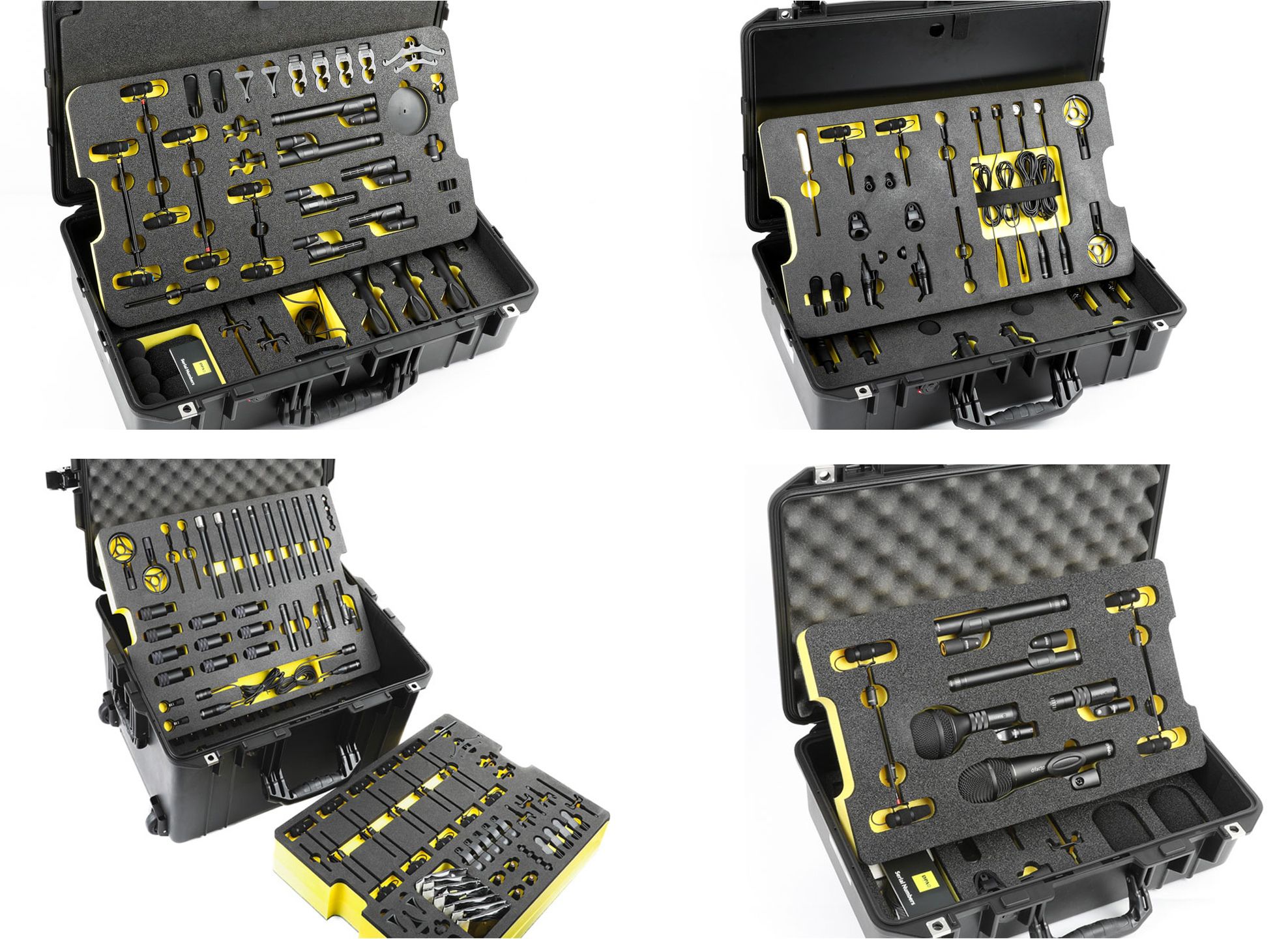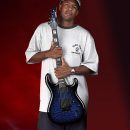Tech 21 SansAmp Character Plus Series Amp Pedals: The Screaming Blonde, The English Muffy, The Fuzzy Brit, and The Mop Top
 The world has changed quite a bit over the last few years with supply chain issues directly impacting the cost and availability of many popular musical instruments, amplifiers, and effects. At the same time, technology for tube amplifier alternatives continues to develop and improve and come in various formats: numerous products provide models, others provide IRs and profiles, and others, like those developed by Tech 21, provide all-analog signal paths that seek to emulate coveted tube amp tones without resorting to digital technology. With artists such as Geddy Lee, Steve Harris, Richie Kotzen, dug Pinnick, and Paul Landers lending their endorsements to signature gear from Tech 21, we are always excited to dig in when they release new products, and we have yet to find ourselves disappointed.
The world has changed quite a bit over the last few years with supply chain issues directly impacting the cost and availability of many popular musical instruments, amplifiers, and effects. At the same time, technology for tube amplifier alternatives continues to develop and improve and come in various formats: numerous products provide models, others provide IRs and profiles, and others, like those developed by Tech 21, provide all-analog signal paths that seek to emulate coveted tube amp tones without resorting to digital technology. With artists such as Geddy Lee, Steve Harris, Richie Kotzen, dug Pinnick, and Paul Landers lending their endorsements to signature gear from Tech 21, we are always excited to dig in when they release new products, and we have yet to find ourselves disappointed.
The original SansAmp Character Series was introduced in 2008 and remains quite popular for artist fly gigs, and Tech 21 has continued to refine and expand the product line. The latest Character Plus Series pedals broaden the range of tonal options and now also include on-board effects in addition to classic amp emulations, as well as two channels.
And what would a cool pedal be without a cool name? The Screaming Blonde is a Fender-style amp pedal with built in Tube Screamer-style overdrive. The English Muffy is a HiWatt-style amp pedal with a Big Muff-style Fuzz. The Fuzzy Brit is a Marshall-style amp pedal with a Fuzz Face-style effect. And last but not least is the Mop Top Liverpool pedal, which is a Vox-style amp with a Rangemaster Booster-style effect.
Features
There are some common features across the four 100% analog pedals in this series. The pedals are all enclosed in a compact, rugged metal encasing and have three easily accessible foot switches: bypass on/off, the effect on/off, and channel A/B switch. They each have a similar layout and similar controls, albeit with a slight variation on the Mop Top Liverpool pedal which we will go into later.
The pedals all have two character channels each with separate volume, character, and drive knobs as well as separate EQ knobs for high, mid, and low. Volume A and B adjust the volume of each corresponding section. Drive A and B adjust the overall amount of gain and overdrive for each channel, similar to adjusting the output section of a tube amp. The first half of the rotation will increase the volume as well as the overdrive.
Character A and B have the same range as each other and differ for each pedal. You could set one cleaner and one dirtier, for example, or set each with a different style in the character range of that pedal. In addition to modifying the frequency response, the character knob also influences the attack and drive characteristics. Thus, you may need to refine your gain and tone settings after adjusting the Character controls. The range of settings for each Character controls differs for each pedal and will be discussed separately below for each pedal.
The low, mid, and high controls provide EQ-based sound shaping, but unlike passive controls that only cut, these active controls cut and boost +/- 12 dB. There are some differences in this section on the English Muffy Pedal.
The effect section differs for each pedal. Each pedal includes essential speaker simulation, which is an integral part of the SansAmp circuitry. It works in tandem with the EQ controls to custom tailor the overall sound.
Each pedal includes a quarter-inch input meant for a standard guitar cable along with a quarter-inch low-Z output. This output can be connected to your amp input or effects loop, as well as Low-Z mixer inputs or computer inputs, making it very flexible. It also buffers the guitar signal, reducing loss of tone along long cables.
There is also a balanced XLR output for direct connection to a PA system. We love that both sets of outputs can be used simultaneously for on-stage monitoring and no-fuss front-of-house mixing. There is a universal power supply set-up with U.S prong assembly and includes adaptors for Europe, UK, and Australia/New Zealand. The pedals measure 1.25” x 7.75” x 2.25”.
The Screaming Blonde is a Fender style amp pedal covering a range of Fender styles from Black- and Silver-face amps to Blonde style amps to Tweed style amps. On the Character knobs, below 12:00 is in the black and silver face style with soft midrange and nice top-end sparkle, but it can be driven to a warmer low-end breakup. Around 12:00 heads into the Blonde territory with more lows, more mids, and more highs. Above 12:00 gets you more into the Tweed era with a more pronounced midrange. And all the way up heads into boosted lead tones. The Screaming Blonde speaker simulation is tuned to match a standard 12” Jenson style speaker. The pedal comes with a tube screamer type of effect, which can be used independently, featuring overdrive, tone and level knobs.
The English Muffy is a HiWatt-style amp pedal—think The Who and some Gilmore/Floyd-style leads. On the Character control knobs, below 12:00 yields clear Hi-Watt-style tones. Around 12:00 brings in a more crunchy amp tone associated with ‘70s The Who-style songs. Above 12:00 accentuates upper mids for Gilmore/Floyd-style lead tones. The full up setting delivers higher gain for full-out rock. The speaker simulation of this pedal is tuned to match Fane-style speakers. This pedal features a Muff-style fuzz effect with sustain, tone and level controls. The pedal is also good for various bass tones a la John Entwistle and Gabriel Genesis.
The Fuzzy Brit pedal brings you an array of Marshall-style tones. Below 12:00 on the Character knob and you get Bluesbreaker/JTM45 tones. Around 12:00 you are getting into the Plexi range with the characteristic throatiness. Above 12:00 gets more into the ‘70s-style Metalface. All the way up and you’ll hear screaming leads that blossom. There is an independent fuzz section with fuzz, tone, and level controls. This pedal is tuned to match English Greenback-style speakers.
The MopTop Liverpool celebrates Vox amp tones. Below 12:00 on the Character knob yields tones of a Top Boost amp. Around 12:00 brings in classic British mids and above 12:00 you get more of the vocal quality of Clapton’s famous “Woman Tone.” Full up gets into boosting low mids for more of a non-Top Boost, AC30 style. This pedal has an independent Boost section which offers two boosts in one knob and at 12:00 it’s flat. When you turn the knob clockwise you get a brighter, louder, edgier ‘60s and ‘70s vintage-style boost. Turning counter-clockwise tightens up distortion, rhythm and lead tones for a more modern style. In addition, this pedal has a Mid Shift switch and a High Shift switch which shift the frequency of the mids and the highs accordingly. The pedal is tuned to match English Alnico Bulldog-style speakers.
Usability
There are four basic uses for each of these pedals. One is as a stompbox with an amp. Easy for travel with a universal power supply and the included various adapters. No need to worry about tubes. Use it as a backup or as a separate amp to mix with your other amp.
Another use is as a pre-amp to drive a power amp. Run it into a cleaner amp and keep the pedal’s tone intact or mix it with other style amps for new tones. Or you can use the stomp effect independently of the amp simulation.
Third, you can run it directly to a mixing board. Voila! No stage noise. Pack this in your guitar travel bag and you're ready to go, and you could even add a small pedal board for other effects if needed. Alternatively, you can use it directly to a board and to an amp at the same time. The two output channels can be used at the same time.
Fourthly, you can run it directly into the soundcard of a computer for recording in a DAW.
The amp section knobs and stomp effect section have different colors to differentiate them so it’s easy to know what's on. Each of the knobs of the amp section have the same color lighting (although different colors on the different pedals) and the knobs are very small, so you need to familiarize yourself with the layout of the pedal if you want to make adjustments quickly between songs. The three switch buttons were very quiet and the units themselves were each very quiet in use.
The EQ sections of each pedal were all very usable throughout their sweeps. How annoying is it to have an EQ on your amp and your bass range is either too boomy or you need it dialed almost all the way off? The EQ section interacts with the Character knobs in the sense that once you get the range of amp you want, you will need to adjust the EQ section that fits best with the guitar you are using and the amp style.
From the descriptions above, you just need to pick a pedal for the basic sound that you’re trying to achieve and go from there. Of course, your guitar and pickups are going to heavily influence the tones you ultimately achieve. Each pedal covers a range of tones from the overall style of amps it's trying to emulate.
A couple of recommendations from Tech 21 in terms of placement: Each pedal can be treated as a conventional amp or pre-amp so keep in mind where you place effect pedals before and after the Character pedal. They recommend to place boost, compression, fuzz, phaser/vibe, overdrive and wah before the pedal and delay, EQ, flanger, phaser, pitch shifter, and reverb after the pedal (much like you would do for an amp with an effects loop). But of course, there is no truly right or wrong way to go.
Sound
A full playlist of the Character Series is on Tech 21's YouTube page, and is a good place to start to really hear the range of each pedal (wear good headphones or use good speakers to listen).
First, we tested each pedal into our computer sound card and DAW. It was late at night and we couldn't wake those damn kids (oops, we meant precious kids lol). We were caught pleasantly off guard at the richness and authenticity of the tones. Each pedal responded well to our nuances in picking and attack. The tones across the range of the Character definitely hit the style of the amps the pedal was trying to model. Cleans were clear and articulate and overdriven and distortion tones were rich and full. We found that having the amp drive at at least 10:00-11:00 helped hit what would be considered a sweet spot for an amp. Of course cranking it higher went into the overdrive amp tones. That being said, depending on what guitar we were using, the sound cleaned up well with rolling off the volume on our guitar. With the drive too low however, most of the tones lacked a bit of life to them.
Each pedal has quite a bit of tonal options. You can set up each pedal so the two channels have different characteristic tones. For example, on the Blonde pedal you can set up channel A to be more in the Blackface tonal spectrum while channel B lives in the Tweed range. Then you can decide how much gain you want on each channel separately. So if you're playing direct into a PA or computer, you could have two very different tones. If you go into an amp then you also then have the characteristics of that amp alone with the pedal in bypass.
Next, you have the stomp effect for each pedal. We ran the pedals directly into a Supro Dual Tone amp dialed in for more clean headroom so we could hear more of the characteristics of each pedal. The Character pedals really transformed the amp into something different, all of which sounded good.
With all the modeling in the world you can't compete with playing through an actual amplifier and speaker feeling the air move. But we also ran the pedals directly into the PA system and again we must have loved it because we didn’t notice the time fly by.
A few notes about each individual pedal. On the Screaming Blonde, with the Character knob all the way up, we got a really cool cocked-wah tone. The tube screamer effect was usable through its sweep and all controls. It maintained its characteristics throughout the gain and volume sweeps, never becoming a high gain distortion. That being said, cranking the drive for the tube part of the pedal up and adding the tube screaming got us into wicked high-gain territory. We did feel the Fender tones were slightly less chimney and glassy than genuine Fender amps we have played, though.
The Fuzzy Brit, Marshall-style pedal, was probably the most versatile sonically from its range of clean to distorted tones while the English Muffy Hi-Watt pedal seemed to have the cleanest headroom, consistent with characteristics of Hi-Watt amplifiers. The fuzz on the Fuzzy Brit was more, well, fuzzy while the Muff style fuzz on the English Muffy maintained a cleaner fuzz tone throughout its sweep, at least until we cranked the amp’s Drive knob.
On the Mop Top, which is a Vox-style amp pedal, the two Character channels offer different amps so you actually have more tonal options from that pedal over all. The boost effect offers an additional tonal palette. Unlike some boost pedals where dialing it up just increases the boost or the gain, above 12:00 we got a brighter boost and below more of mellow, tighter boost. This gave us the flexibility to make sure our guitar didn’t get lost in the mix when we clicked on the boost for a solo or a little more “oomph” in the chorus. Of note, however, we didn't really notice much tonal difference with either the mid or high shift switches engaged despite experimenting with it in a few different ways.
Which pedal do you choose? That's a tough decision and may in part be decided by which effects you want since you only get one effect in each pedal. Unlike some of the amps being modeled, each pedal has quite a bit of tonal options from clear to full-on gain, plus the stomp effect. If we had to pick one it would be the Fuzzy Brit. No, wait, the Screaming Blonde. No, we meant the English Muffy. Huh? We said The Mop Top. As you can see, they are each great choices depending on your personal tone preference.
Documentation and Product Support
There is one manual in each box that includes directions for all the pedals and was very helpful in explaining the range of settings and character options. We appreciated that there were four sample settings for each pedal plus a section in the back to write down some custom settings. The manual is also accessible online.
Price
The Tech 21 SansAmp Character Plus pedals (MSRP $375) sell for approximately $280 street. In the scheme of modeling amp options that offer many more amps and stompboxes, that may seem expensive. However, for the quality of the analog tones, output options, build quality, and independence of the SansAmp and effect sections, and dual and simultaneous output options, we think this is a fair price.
Contact Information
Tech 21
www.tech21nyc.com

